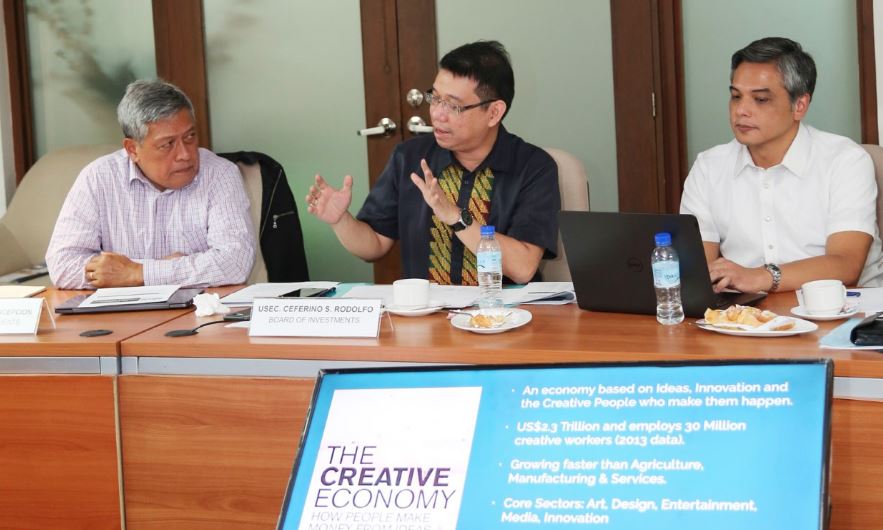The Creative Economy Council of the Philippines (CECP) recently submitted to the Department of Trade and Industry (DTI) and the Board of Investments (BOI) the Creative Economy Roadmap for more inputs before eventual acceptance and implementation.
The move is an offshoot of the Memorandum of Understanding (MOU) signed on December last year between the DTI-BOI, CECP along with the National Commission for Culture and the Arts (NCCA) and the British Council (BC) which aims to establish a strong Inter-agency public and service sector collaboration in the formulation and implementation of plans and program for the promotion and development of the Philippine creative economy.
 |
| Photo shows Trade Undersecretary and BOI Managing Head Ceferino Rodolfo (center) along with BOI Govenor Napoleon Concepcion and DTI-EMB Assistant Director Anthony Rivera discussing with the stakeholders of the Creative Economy during the submission of Creative Economy Roadmap. |
During the meeting, Trade Undersecretary and BOI Managing Head Ceferino Rodolfo said that given its broad structure, there is a need to define the Creative Economy within the Philippine context and suggested to shortlist at least five sectors from the cultural and related domains fora more “granular” focus and “doable” approach in crafting the specific action plans of the roadmap.
CECP President Paolo Mercado identified advertising, film, animation, game development and design (specifically graphic and digital design) as among the five priority sectors to come up with specific action plans.
The roadmap envisions that “by 2030, the Philippines will be the number one Creative Economy in ASEAN in terms of size and value of our creative industries, as well as the competitiveness and attractiveness of our creative talent and content in international markets.” The scope includes six cultural domains, namely: cultural and natural heritage; performance and celebration; visual arts and artisan products; books and press; audio-visual, broadcast and interactive media; and creative services. Other related domains include tourism, and sports and recreation.
The creative industries have been an important source of trade and investment opportunities which provide access to more economic opportunities for the micro, small and medium enterprises (MSMEs). The roadmap is seen to further cultivate the country’s creative industries particularly its high value services that provide major contributions to the GDP, such as tourism, Information Technology – Business Process Management (IT-BPM) and other creative services. It can also serve as an important tool towards achieving sustainable creative economy amidst rapid marriage of physical and digital technologies brought about by the Fourth Industrial Revolution (Industry 4.0).
Among the policy recommendations in the Creative Economy Roadmap include declaring Creativity as a National Priority via a Creative Economy Executive Order and a Creative Economy Act to create a Creative Economy Agency; mapping, measurement of priority creative industries for accelerated growth in domestic and international markets; encouraging and incentivizing the development of creative hubs and creative clusters as places for incubation, production, education and research and development; pushing for Philippine Creative Cities development and recognition; promotion of new models of creative tourism that will enhance the country’s image and promote sustainable tourism and prioritizing creative education programs to strengthen the country’s creative workforce to become the Creative Education Capital of ASEAN.
The meeting concluded with several additional recommendations to the finishing touches of the Roadmap. Undersecretary Rodolfo said there should be a body who will be on top of the roadmap implementation.
For the next step, a technical working group (TWG) will be formed to include the Department of Tourism (DOT), Department of Education (DEPED), Commission on Higher Education (CHED) and Technical Education and Skills Development Authority (TESDA). The BOI, DTI-EMB, and CECP, will take the lead and oversee the formulation of action plans to implement the roadmap.
He pointed out that the TWG must agree on priority sectors and come up with a more specific strategy in addressing common issues. In terms of nurturing talents, Undersecretary Rodolfo suggested in exploring the benefits of TESDA’s “voucher system” of and DTI’s Shared Service Facilities (SSF) Project. He also added that making concrete roadmaps for animation, game development, and film headed by their respective associations would complement the Creative Economy and once in place, could be given tax incentives under the upcoming Strategic Investments Priority Plan 2020 – 2023 (SIPP). (END)


